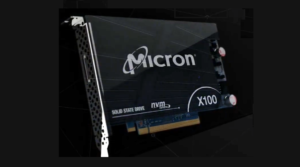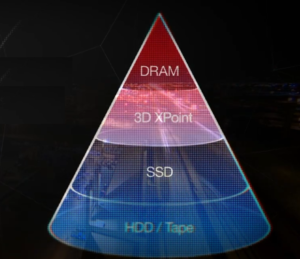
Micron Delivers 3D XPoint Drive, Acquires FPGA Device Maker

Micron Technology today unveiled the X100, a new solid-state drive based on 3D XPoint technology that the company claims is the fastest in the world. It introduced two other NAND and NVMe-based SSDs at its show in San Francisco, as well as the acquisition of FWDNXT, which develops a deep learning solution that includes FPGA hardware.
Micron partnered with Intel back in 2015 to develop 3D XPoint, the memory-class storage technology that promises to deliver DRAM-like performance in an SSD form factor. But the Boise, Idaho-based company parted ways with the chip giant before either of them could bring the nascent technology to market. Intel has since continued its 3D XPoint development with its Optane line of storage technology, which is in the process of rolling out.
With the unveiling of the X100 at its Insight 2019 conference, Micron is one step closer to actually delivering on the 3D Xpoint promise. The specs on the NVMe drive, which is currently in limited availability, look quite promising:
- Up to 2.5 million IOPS, which it claims is the fastest in the world;
- More than 9GB per second bandwidth for read, write, and mixed workloads, which it claims is 3x faster than comparable NAND drives;
- And read-write latency of less than 8 microseconds, which it claims is 11x better than NAND-based SSDs.

3D XPoint blends the persistence of disk with the performance of DRAM (Image source: Micron Technology)
Micron sees the X100 serving data to the world’s most demanding analytics and transactional applications, a role that’s befitting the world’s fastest drive. The drive is seen delivering data to big number-crunching workloads in the fields of analytics, streaming, and machine learning, across fields like finance, healthcare, genomics, and IoT.
The new drive “brings the disruptive potential of 3D XPoint technology to the data center,” says Sumit Sadana, Micron’s executive vice president and chief business officer. “Micron is the only vertically-integrated provider of DRAM, NAND, and 3D XPoint solutions in the world, and this product continues the evolution of our portfolio towards higher value solutions that accelerate artificial intelligence capabilities, drive faster data analytics and create new insights for our customers.”
It also launched the Micron 7300, a data-center class NVMe SSD that has capacities from 400GB to 8TB, depending on the form factor. The 7300 can read data at rates up to 3 GBps, write data at speeds up to 1.8 GBps, and deliver random write latency of 25 microseconds. It’s ideal for a range of I/O-sensitive workloads and high throughput environments like AI, the company says.
The new Micron 5300, meanwhile, is a SATA class drive with capacities from 240GB to nearly 8TB. This disk, which Micron claims is the industry’s first SATA drive built on 96-layer 3D TLC NAND, can deliver random read performance of up to 95K IOPS and random write IOPS of 75K. It also unveiled the Crucial X8 Portable SSD, which is Micron’s first consumer-oriented portable SSD.
Meanwhile, Micron moved into the AI space in a big way with the acquisition of FWDNXT (pronounced “forward next”), a Lafayette, Indiana-based AI startup that claims to develop a “complete” deep learning solution.
FWDNXT’s develops a software development kit (SDK) for developing a range of neural network models, and also offers compilers that enable those models to run its Inference Engine cards, which come equipped with Xilinx-based field programmable gate arrays (FPGAs). The company’s offerings are commonly used for solutions like facial recognition, self-driving cars, speech recognition, and reinforcement learning, according to its website.
With this acquisition, Micron says it’s integrating the compute, memory, tools, and software into a “comprehensive AI development platform,” which it dubbed the Micron Deep Learning Accelerator (DLA).
“FWDNXT’s five generations of machine learning inference engine development and neural network algorithms, combined with Micron’s deep memory expertise, unlocks new power and performance capabilities to enable innovation for the most complex and demanding edge applications,” Sadana said in a press release.
The company’s nascent DLA offering is already being used, including by doctors and researchers at Oregon Health & Science University, where images from electron microscopes are being analyzed to find insights into treating cancer. It’s also working with physicists at “leading nuclear research organizations” to use convolutional neural networks developed with DLA to analyze the results of high energy particle collisions.
In late breaking news, Micron also announced investment in Volocopter, a builder of electrically powered helicopters, to expand mobility in the skies. Insight 2019 concludes today.
Related Items:
The State of Storage: Cloud, IoT, and Data Center Trends
The Future of Storage: Hardware
Micron Aims at Big Data With New Parallel Processing Architecture































